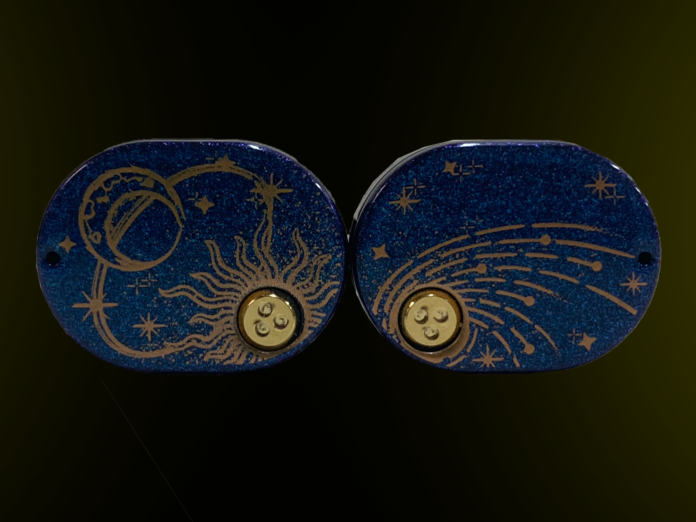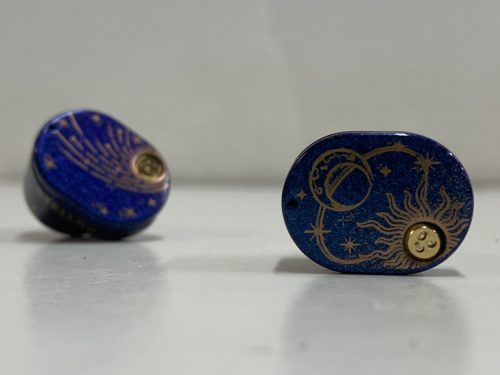Moondrop has become one of the most popular brands for affordable IEMs. They have a slate of fantastic earphones ranging from the $20 Chu to the $189 Kato. There are selections beyond that for higher prices, but in terms of what is economical, Moondrop has plenty of options. A new option has now made its way to the market with Moondrop’s Stellaris IEMs. Going for only $109, the Stellaris is not only another budget option for an entry-level, it is also Moondrop’s first planar IEM. Planar IEMs have been showing up quite a lot recently, and now Moondrop has one to compete with. Let’s see how Moondrop incorporates this new element.
What You Get
- Stellaris IEMs
- Carrying case
- 3 pairs of Moondrop silicone tips
- 3 pairs of Moondrop foam tips
- 2-pin 3.5mm cable
- User Guide
Look and Feel
Promo images for the Stellaris do not do these IEMs justice. Moondrop always carries an artistic design with their products and the Stellaris is one of the best in their library. Opening the box and holding the Stellaris earphones in my hand, I was shocked by how different they were compared to others in their library. The Stellaris has a particular build that is a departure from some of Moondrops usual methods. Its body is like a larger version of the Chu, with a weightier feel and a striking surface. Its whole aesthetic is this beautiful stary night in purple. Outside of its artistry, the cavity is oddly shaped. The spout is weirdly long, and it makes the housing stand up straight outside your ear rather than sit in your concha. It isn’t a perfect fit, but a sturdy one that stays in your ear with minimal fatigue.
Design
This planar driver is 14.5mm, with a sub-nanometer diaphragm. It is uniformly stressed for non-linear distortion and split vibration in an attempt to produce a clearer signal. There is also a modified acoustic structure within the housing of the Stellaris in hopes of more natural details in its sound reproduction.
- Sensitivity: 117dB/Vrms (@1kHz)
- Impedance: 36Ω±15% (@1kHz)
- Frequency response: 10Hz-50kHz
Soundstage
Hearing Moondrop and planar put together, some expectations are built up. The soundstage is where these expectations are going to culminate the most. After getting some time with the Stellaris, it was one of my favorite aspects. It has a lot of properties that planar drivers can deliver, like increased width and layering. The stereo image is given enhanced height and depth on the Stellaris. There’s some striking spatial separation that defines each section of the mix from the left channel to the right. You also get a non-linear presentation of sound elements, with instruments and effects overlapping each other with good separation and clarity.
A greater dimension is added to each position in the stereo field, stacking above and below the other. It is an open soundstage that still feels intimate, like a good closed-back headphone. The planar characteristics help obtain that level of performance in the Stellaris. I also felt some wrap-around to these IEMs as well, establishing more immersion through holographic imaging.
Low End
While the bass does not slam as hard as I think it should, the feeling is there. It is most fulfilling in the sub-bass, where the timbre is crystal clear. You can feel the rumble and vibration with depth and articulation. The frequencies reveal themselves with a realistic tone, which might not always be the most fun or engaging. This is a more feel-it rather than hear-it type of signature, and that experience was engrossing enough for me. Even if the mid-bass lacks a powerful punch, it still has a well-balanced presence that establishes a good foundation of low-end detail.
Mids
There is a ton of room in these mids. The frequencies within this space have a good body to them, pronouncing instrumentals and vocals in ways that make them easy to identify. This is the most linear region of the sound signature, but it never feels limiting. There’s some nice snappiness to certain instruments like electric guitar solos and piano notes. You can feel the quickness of their tone. It gives each part of the mix weight and power, which excited the sound signature of the Stellaris in a significant way. Vocals have a natural presence in the mix. They are placed in the center with accuracy and possess a slight height that gives the frequencies in this region an airier feel.
Highs
The treble of the Stellaris is one of its best features. Its timbre is wonderfully crisp and airy, showcasing colorful textures. They add so much definition to hi-hats and tambourines, making them glisten and sparkle in the mix. Their resonance is always well controlled, and only highlights elements that keep the region from sounding harsh. This is a more delicate tone, that coats the top of the sound signature with an enticing shine.
Summary
The Stellaris is yet another great IEM from Moondrop. Not only is it affordable, but it carries a great sound. It features a wide and airy soundstage with clear details in the bass and mids and extraordinary texture in the highs. You also won’t find another IEM at this price with such a striking design, even if the fit is a little questionable. For only $109, Moondrop has created another great product for that entry-level audiophile market.
| Pros | Cons |
|
|
The Moondrop Stellaris is available at Audio46.
MAJORHIFI may receive commissions from retail offers.












